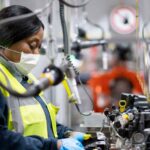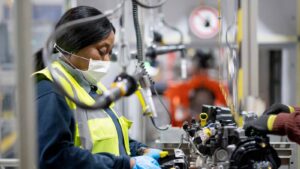
March 13, 2023
It is an extraordinary time for the manufacturing industry: We will soon watch major advancements in products and processes take off in the United States, thanks to the recent passage of the bipartisan CHIPS and Science Act. This act puts into motion the largest investment in American manufacturing policy in the past fifty years – and includes vast new resources to support entrepreneurs.
The CHIPS and Science Act invests a whopping 280 billion USD over the next 10 years into (as the name suggests) CHIPS and Science. This includes 52 billion USD specifically for companies that manufacture semiconductor chips and other items in the US — a colossal opportunity that promises to revolutionize the field. In addition to advancing US industrial capabilities, the Act also seeks to overcome the lack of diversity among manufacturing owners and workers. It has the stated ambition of leaving no American behind.
Yet few outside of Washington, DC know the CHIPS and Science Act exists. And even fewer know how to synthesize the 1000+ page document into applicable chunks and practical programming or, in other words, how to concretely take advantage of the opportunity. How then does the Act serve its intended role, to challenge the industry while meeting the diverse demands of the moment?
What’s needed, first and foremost, is a clear and effective communication strategy for disseminating information about the CHIPS and Science Act to HBCU administrators, educators, students, and alumni.
Follow our column in Force Distance Times, The Modern Manufacturer, as we unpack sections of the CHIPS and Science Act through interviews with thought leaders and practitioners. And, most importantly, do your part by sharing this column with people who you think could benefit.
For the first interview, Jeannine A. Cook, a Storyteller with the Urban Manufacturing Alliance (UMA), traveled to Washington D.C. to converse with Michelle Burris, Fellow at The Century Foundation (TCF). In a series of personal conversations, the two unpacked the recently passed CHIPS and Science Act and its 52 billion USD promise tag. In particular, they focused on portions of the Act designed to provide direct support to Historically Black Colleges and Universities (HBCUs).
“Literally less than 1% of federal research funding was even going to HBCUs all these years [before CHIPS],” said Burris, a HBCU graduate and fellow at the 103-year-old think tank, The Century Foundation. “And yet, the beautiful thing is that HBCUs have been able to thrive. They’ve been building some of the greatest entrepreneurs despite the historic underfunding, but now there’s funding there to put them on another level.”
The CHIPS and Science Act prioritizes research and innovation, “and no disrespect, but this act makes sure that it’s not only MIT, Stanford, and John Hopkins at the center of this funding. So if done correctly with the proper community engagement, it can put HBCUs at an equitable caliber that they haven’t had access to since their founding,” Burris emphasized.
If this Act is to make a true difference, a concentrated effort on healing the race and class tensions that exist in communities around manufacturing, workforce development, and entrepreneurship has to be considered.
Funding HBCUs has been a source of contention in the United States since the late 1800s. Starting and maintaining HBCUs is incredibly difficult considering the same people who benefitted from institutions like slavery and Jim Crow are expected to then fund HBCUs designed to directly undermine the effects of slavery and Jim Crow. Seems counterintuitive. And still HBCUs continue to play one of the most significant roles in shaping American culture — nurturing a range of notables from scholars to politicians, from artists to innovators.
The CHIPS and Science Act promises new resources and policies to allow 100+ Historically Black Colleges and Universities and other Minority-Serving Institutions (MSIs) to participate equitably and genuinely in research funding. But while the bill’s focus on diversity is commendable, especially when it comes to manufacturing, the United States has a tremendous amount of work to do if it plans on using these resources to create racial equity in this industry. One part of that work includes creating and implementing systems of repair.
According to the US Census Bureau, 90 percent of manufacturing firms are white-owned, 4.6 percent are Hispanic-owned, 4.5 percent are Asian-owned, and less than 1 percent are Black-owned. Among that tiny fraction, Black-owned manufacturing firms are more likely to be new (less than three years old), and employ fewer workers per firm.
When asked to share a specific story about an HBCU that she believes will benefit from this funding, Burris mentioned Baltimore-based Morgan State University. “Morgan has historically been given pennies on the dollar compared to predominantly white institutions in Maryland. To the extent where they had to sue the state. Morgan State is not charging students a fortune. And Morgan State is right by John Hopkins and they are trying to compete at that same federal level, because the intellect is the same. It’s just the infrastructure and the resources are not.”
So what’s needed, first and foremost, is a clear and effective communication strategy for disseminating information about the CHIPS and Science Act to HBCU administrators, educators, students, and alumni. According to Burris, “there has to be a regular cadence of communication with HBCUs. I’ve visited many communities who could benefit from this, but had never heard of it.” Sororities and fraternities are an underutilized pipeline for disseminating information.
In addition to a communications strategy, if the CHIPS and Science Act is designed to introduce new communities to this funding, doing so will require major and continued technical assistance for applicants and ongoing championing from congressional leadership.
But perhaps most importantly if this Act is to make a true difference, a concentrated effort on healing the race and class tensions that exist in communities around manufacturing, workforce development, and entrepreneurship has to be considered. The Morgan State University lawsuit perfectly exemplifies the challenges the relationships between HBCUs, manufacturers, and community members face. After decades of legal battles and intentional underfunding, how do we mend these relationships? Is it even possible? “Healing is crucial,” emphasized Burris. “Because that goes back to making sure there is a human-centered approach. You can overlook it as much as you want. But when you end up having a desperate need for workers, as we see in manufacturing, you have to do that people centered work.”
If the CHIPS Act engenders a true commitment to overcoming the lack of diversity among manufacturing owners and workers, clear and consistent communication to and from HBCUs, along with financial investment in the capacity and STEM capabilities of HBCUs must be prioritized. To read more about how the CHIPS and Science Act can lead to inclusive innovation in the manufacturing sector, read the policy brief on the subject co-written by the Urban Manufacturing Alliance and The Century Foundation.
The Urban Manufacturing Alliance (UMA) is a national coalition of practitioners who believe that manufacturing is a strategy for economic mobility, particularly for BIPOC and other underserved communities, through career pathways, entrepreneurship, and ownership. We build interwoven national and local ecosystems of those who traditionally associate with manufacturing, as well as those who do not, to authentically connect the opportunities manufacturing provides to those who it would most benefit. This coalition works together to grow more equitable and prosperous economies in cities by building a robust, sustainable, and inclusive urban manufacturing sector. Learn more at www.urbanmfg.org.
Michelle Burris is a fellow at The Century Foundation, focusing on racial and gender equity in workforce development. She helps to lead the Industry and Inclusion Cohort. Prior to joining TCF, Michelle was a teacher at Truman High School in New York City working with African immigrant students. She also served in the United States Peace Corps in Rwanda, teaching English at a boarding school. Michelle participated in internships at the White House and was a congressional fellow in Congressman Jim Cooper’s office. She graduated from Spelman College with a BA in political science, and holds a MA in politics and education from Teachers College, Columbia University.





No comment yet, add your voice below!